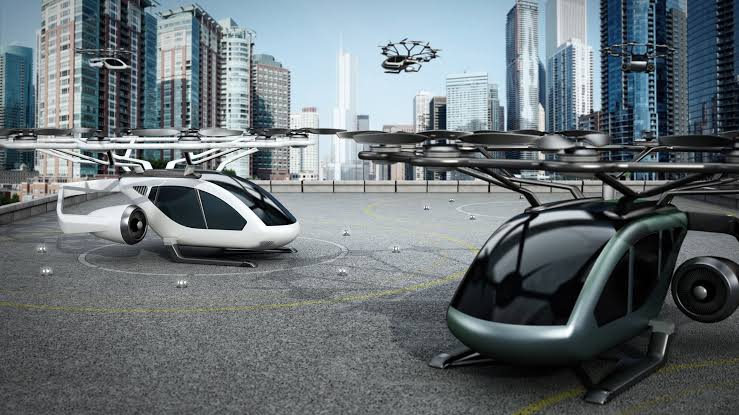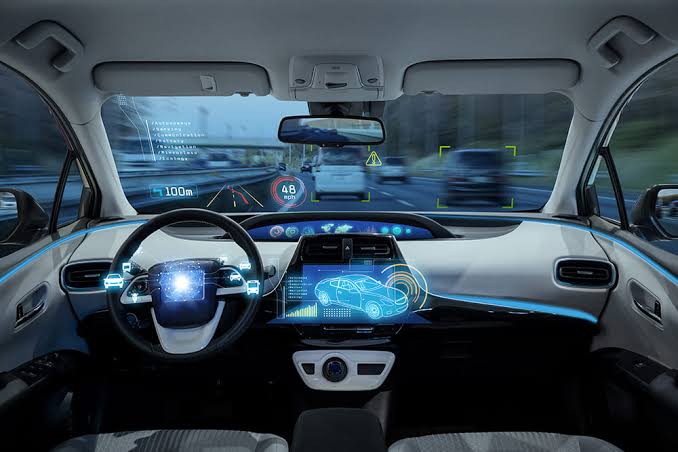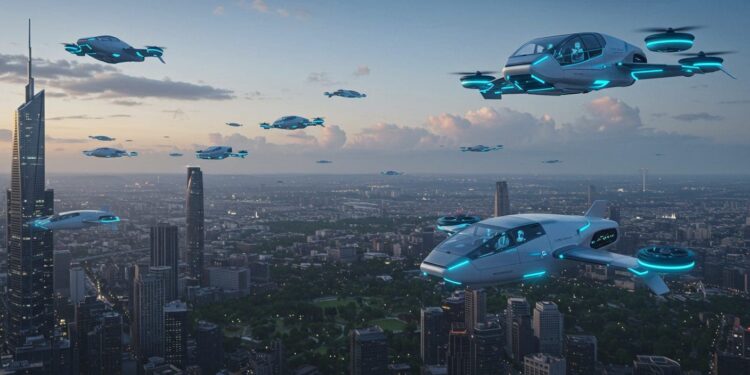Imagine a world where robots handle chores, computers process information at unprecedented speeds, and flying cars transform transportation. This isn’t a scene from a sci-fi movie; it’s the potential reality of 2030. As we approach this milestone, various concepts once considered futuristic are becoming a reality.
According to recent articles, we’re on the cusp of significant advancements that will transform our lives. Humanoid robots are being developed to assist in daily tasks, while quantum computing promises to revolutionize data processing.

Key Takeaways
- Emerging technologies like humanoid robots and quantum computing are transforming our daily lives.
- These advancements are expected to significantly impact various industries by 2030.
- The integration of sci-fi concepts into reality is happening faster than ever.
- Understanding these technologies is crucial for embracing the future.
- The potential benefits and challenges of these technologies are vast and varied.



The Dawn of Science Fiction Becoming Reality
As we step into the future, the line between science fiction and reality is becoming increasingly blurred. The pace of technological innovation is accelerating at an unprecedented rate, turning what was once considered science fiction into reality.
From Fantasy to Feasibility: The Accelerating Pace of Innovation
The computational upsurge and advancements in AI, robotics, and quantum computing are transforming industries. These emerging technologies are not only enhancing existing processes but also creating new possibilities that were previously unimaginable.
Key areas of innovation include:
- Artificial Intelligence
- Robotics
- Quantum Computing
- Advanced Materials
Why 2030 Is a Critical Threshold for Emerging Technologies
By 2030, we can expect significant advancements in various fields, making it a critical threshold for emerging technologies. The convergence of multiple technologies will lead to breakthroughs in areas such as sustainable energy, transportation, and healthcare.
| Technology | Current Status | 2030 Projection |
|---|---|---|
| Quantum Computing | Early adoption phase | Widespread commercial use |
| Humanoid Robots | Prototype development | Integration into daily life |
| Flying Cars | Testing and regulation | Commercial availability |
The future is unfolding at a rapid pace, and understanding these emerging technologies is crucial for navigating the changes they will bring.
Humanoid Robots: The New Workforce Revolution
With advancements in AI, humanoid robots are on the cusp of a breakthrough, ready to integrate into our daily lives and workplaces. The development of these robots is accelerating, driven by significant investments from tech giants.

Current State of Humanoid Robotics
The current state of humanoid robotics is characterized by rapid advancements in AI and robotics. Companies like Tesla, Boston Dynamics, and Amazon are leading the charge.
Tesla Optimus: Elon Musk’s Vision for Household Robots
Tesla Optimus, a humanoid robot developed by Tesla, represents a significant step towards household robots that can perform various tasks. Elon Musk’s vision is to make these robots an integral part of daily life.
Boston Dynamics Atlas: The Acrobatic Humanoid
Boston Dynamics Atlas is known for its acrobatic capabilities, showcasing the agility and flexibility of humanoid robots. This technology has potential applications in industries requiring complex physical tasks.
Amazon’s Digit: Reshaping Warehouse Operations
Amazon’s Digit is designed to work in warehouses, enhancing efficiency and reducing labor costs. This robot demonstrates the potential for humanoid robots in logistics and supply chain management.
Job Market Disruption Predictions
The introduction of humanoid robots into the workforce is expected to disrupt various industries. From retail automation to manufacturing transformation, the impact will be significant.
Retail Automation: Self-Checkout to Full Robot Staff
Retail is one of the sectors that will see significant changes, with humanoid robots potentially replacing some roles currently performed by humans.
Manufacturing Transformation
In manufacturing, humanoid robots will enhance production lines, improving efficiency and reducing costs.
Healthcare Assistance and Elderly Care
Humanoid robots will also play a crucial role in healthcare, providing assistance and companionship to the elderly.
Ethical Considerations in Human-Robot Coexistence
As humanoid robots become more prevalent, ethical considerations will come to the forefront. Issues such as unemployment risks and the future of human-robot collaboration need to be addressed.
Unemployment Risks and Economic Impacts
The potential for job displacement is a significant concern. Strategies to mitigate these impacts will be crucial.
The Future of Human-Robot Collaboration
Ultimately, the future of humanoid robots lies in their ability to collaborate effectively with humans, enhancing productivity and quality of life.
Quantum Computing: Processing Power Beyond Imagination
As we stand on the brink of a quantum computing era, the potential for solving complex problems is becoming increasingly evident. Quantum computing has the potential to revolutionize various industries by performing calculations beyond the capabilities of classical computers.
Understanding Quantum Computing Fundamentals
At the heart of quantum computing are qubits, which differ significantly from classical bits. Unlike classical bits that exist in a 0 or 1 state, qubits can exist in multiple states simultaneously.
Qubits vs. Classical Bits: The Quantum Advantage
The primary advantage of qubits lies in their ability to process a vast number of possibilities simultaneously, thanks to the principles of superposition and entanglement. This allows quantum computers to solve certain problems much faster than their classical counterparts.
Superposition and Entanglement Explained
Superposition refers to the ability of a qubit to exist in multiple states at once. Entanglement is a phenomenon where qubits become interconnected, allowing the state of one qubit to affect the state of another, even when separated by large distances.
The Quantum Computing Race
Several major players are at the forefront of the quantum computing race, including IBM, Google, and D-Wave.
IBM’s Quantum Roadmap
IBM has been actively developing its quantum computing capabilities, with a roadmap that includes significant advancements in qubit quality and error correction.
Google’s Quantum Supremacy Claims
Google has made notable claims regarding quantum supremacy, demonstrating the ability of its quantum computer to perform certain tasks beyond the capabilities of classical computers.
D-Wave’s Quantum Annealing Approach
D-Wave has taken a different approach with its quantum annealing technology, focusing on solving optimization problems.
Practical Applications Transforming Industries
- Revolutionizing Drug Discovery and Development: Quantum computing can simulate complex molecular interactions, potentially accelerating drug discovery.
- Post-Quantum Cryptography: The advent of quantum computing necessitates the development of quantum-resistant cryptographic algorithms.
- Climate Modeling and Environmental Solutions: Quantum computers can model complex environmental systems, helping to identify solutions to climate change.
Flying Cars and eVTOLs: The Future of Urban Transportation
With companies like Alef, Joby Aviation, and EHang at the forefront, flying cars and eVTOLs are poised to transform urban mobility. The concept of flying cars has transitioned from science fiction to a tangible reality, promising to revolutionize how we travel within cities.
Leading Projects Taking Flight
Several pioneering projects are making significant strides in the development of flying cars and eVTOLs. These innovations are not only enhancing the feasibility of urban air mobility but also paving the way for a future where commuting by air is a norm.
Alef Model A: The First FAA-Approved Flying Car
The Alef Model A has garnered attention for being the first flying car to receive FAA approval. This milestone underscores the progress being made towards making flying cars a reality.
Joby Aviation’s Air Taxi Vision
Joby Aviation is working on an air taxi service that promises to transform urban transportation. Their eVTOL aircraft are designed for efficiency and safety, marking a significant step towards commercial air taxi services.
EHang’s Autonomous Aerial Vehicles
EHang is at the forefront of developing autonomous aerial vehicles (AAVs), which are set to redefine urban air mobility. Their technology focuses on safety, sustainability, and accessibility.
Overcoming Critical Challenges
Despite the progress, several challenges need to be addressed before flying cars and eVTOLs become commonplace. These include developing robust air traffic control systems, improving battery technology, and reducing costs.
Air Traffic Control for Thousands of Flying Vehicles
Managing the air traffic of numerous flying vehicles is a complex task. Developing sophisticated air traffic control systems is crucial for safe and efficient urban air mobility.
Battery Technology Limitations
The current limitations in battery technology pose a significant challenge. Enhancements in battery life and charging speed are essential for the viability of eVTOLs.

Realistic Timeline for Commercial Availability
The path to commercial availability is fraught with regulatory hurdles and infrastructure requirements. Companies are working closely with regulatory bodies to meet certification standards.
Regulatory Hurdles and Certification Processes
Navigating the complex regulatory landscape is a critical step towards commercialization. Companies must comply with stringent safety and performance standards.
Infrastructure Requirements
The development of necessary infrastructure, such as vertiports and charging stations, is vital for the successful integration of flying cars and eVTOLs into urban landscapes.
The future of urban transportation is on the cusp of a revolution, with flying cars and eVTOLs leading the charge. As technology advances and challenges are overcome, we can expect to see significant changes in how we commute.
Future Technology Trends: From Sci-Fi Tech to Everyday Reality
The convergence of multiple technologies is paving the way for a future where today’s sci-fi becomes tomorrow’s norm. As we move towards 2030, the pace of technological innovation is accelerating, driven by advancements in areas such as artificial intelligence (AI), materials science, and quantum computing.
The Convergence of Multiple Technologies
The future is being shaped by the intersection of various technological disciplines. Two key areas driving this convergence are:
AI as the Enabling Force
AI is increasingly becoming the backbone of modern technological advancements. It enables machines to learn, adapt, and interact with humans in more sophisticated ways. For instance, AI-powered algorithms are now capable of processing vast amounts of data, leading to breakthroughs in fields like healthcare and finance.
Materials Science Breakthroughs
Advances in materials science are providing the physical foundations for many emerging technologies. New materials with unique properties are being developed, such as superconductors, nanomaterials, and metamaterials, which are crucial for the development of future tech trends.
Consumer Adoption Patterns
Understanding how consumers adopt new technologies is crucial for predicting future tech trends. The journey from early adopters to mainstream users is influenced by several factors:
From Early Adopters to Mainstream Users
Early adopters are typically tech-savvy individuals who are eager to try out new technologies. As these technologies mature and become more user-friendly, they gradually gain acceptance among the broader population.
Price Points and Accessibility Factors
The cost of new technologies and their accessibility play significant roles in determining their adoption rates. As production costs decrease and technologies become more widely available, they become more appealing to a larger audience.
To illustrate the impact of these factors, consider the following table that outlines the progression of several emerging technologies from their initial stages to mainstream adoption:
| Technology | Early Adoption Phase | Mainstream Adoption Phase |
|---|---|---|
| AI Assistants | Initial voice recognition challenges | Advanced voice recognition and integration into daily life |
| Electric Vehicles | Limited range and high costs | Increased range, lower costs, and widespread charging infrastructure |
| Augmented Reality | Niche applications in gaming and education | Mainstream use in retail, education, and entertainment |
Global Innovation Hubs Leading the Way
Several global innovation hubs are at the forefront of driving technological advancements. These hubs foster collaboration between tech companies, startups, and research institutions, accelerating the development and adoption of new technologies.
Neuralink and Brain-Computer Interfaces: Merging Mind and Machine
The advent of Neuralink’s brain-computer interface technology is poised to redefine the boundaries between humans and machines. As we stand on the cusp of this technological revolution, it’s essential to understand the current state of Neuralink and its implications for the future.
Current State of Neural Interface Technology
Neuralink is making significant strides in the development of its brain-computer interface technology. The company’s progress in human trials is a critical step towards bringing this innovative technology to the masses.
Neuralink’s Human Trials Progress
Neuralink’s human trials are focused on assessing the safety and efficacy of its brain chips. The initial results have shown promise, with the potential to treat a range of medical conditions.
Medical Applications for Paralysis and Blindness
The technology holds significant promise for treating paralysis and blindness. By enabling direct communication between the brain and external devices, Neuralink’s brain-computer interfaces could restore motor functions and vision in individuals affected by these conditions.

Ethical and Privacy Concerns
While the potential benefits of Neuralink’s technology are substantial, there are also significant ethical and privacy concerns that need to be addressed. The sensitive nature of neural data raises questions about security and privacy.
Neural Data Security Risks
One of the primary concerns is the risk associated with neural data security. As brain-computer interfaces become more prevalent, ensuring the security of the data they generate will be paramount.
Potential for Unauthorized Brain Access
Another concern is the potential for unauthorized access to brain signals. This could have serious implications for individual privacy and security, highlighting the need for robust safeguards.
The Future of Human Cognition Enhancement
Beyond medical applications, Neuralink’s technology also holds the potential for enhancing human cognition. This could involve memory enhancement and storage, as well as more direct integration with artificial intelligence.
Memory Enhancement and Storage
The possibility of enhancing human memory through Neuralink’s technology is an exciting prospect. This could have significant implications for individuals with memory-related disorders.
Direct Brain-AI Integration Possibilities
Perhaps most intriguingly, Neuralink’s technology could enable direct integration between the human brain and artificial intelligence systems. This could revolutionize the way we interact with technology and potentially redefine the boundaries of human intelligence.
Space Technology: The Final Frontier Becomes Accessible
The realm of space technology is on the cusp of a revolution, with advancements that promise to make the final frontier more accessible than ever. Recent developments in areas such as reusable rockets, advanced propulsion systems, and private space companies are driving this change.
SpaceX Starship and the New Space Race
One of the most significant developments in space technology is SpaceX’s Starship, a reusable spacecraft designed for long-duration missions to the Moon, Mars, and other destinations in the solar system.
Mars Colonization Plans
SpaceX has ambitious plans to use Starship for Mars colonization, with the goal of establishing a permanent, self-sustaining human presence on the Red Planet. This involves not just transporting people but also creating the infrastructure necessary for a thriving colony.
Lunar Base Development
In addition to Mars, Starship is also slated to play a crucial role in lunar base development. NASA’s Artemis program, for instance, aims to return humans to the Moon by 2025, with plans to establish a sustainable presence on the lunar surface.
Commercial Space Tourism
The growth of commercial space tourism is another exciting development in space technology. Companies like Virgin Galactic and Blue Origin are pioneering suborbital flight experiences, while others are working on orbital hotels and space vacations.
Orbital Hotels and Space Vacations
Orbital hotels represent a new frontier in space tourism, offering the potential for extended stays in space. These hotels could cater to a range of activities, from leisure and entertainment to scientific research and education.
Suborbital Flight Experiences
Suborbital flights, on the other hand, provide a more immediate and accessible way for people to experience space travel. Companies are working to make these experiences safe, reliable, and affordable for a broader audience.
Space Manufacturing and Resource Utilization
Space manufacturing and resource utilization are critical areas that are expected to drive future advancements in space technology. The ability to manufacture goods in space and utilize space-based resources could significantly reduce the cost and complexity of space missions.
Asteroid Mining Potential
Asteroid mining is one area with vast potential. Asteroids are rich in resources such as water, precious metals, and rare minerals, which could be exploited to support future space missions and even provide a new source of revenue.
Zero-Gravity Production Advantages
Zero-gravity environments also offer unique advantages for manufacturing. Certain materials and products can be produced more efficiently or with unique properties in microgravity, opening up new possibilities for industries ranging from pharmaceuticals to advanced materials.
| Technology | Application | Potential Impact |
|---|---|---|
| SpaceX Starship | Mars Colonization, Lunar Base Development | Permanent human presence beyond Earth |
| Commercial Space Tourism | Suborbital Flights, Orbital Hotels | Expanded access to space for leisure and research |
| Space Manufacturing | Asteroid Mining, Zero-Gravity Production | New resources, improved manufacturing capabilities |
“The future of space technology is not just about exploring new destinations but also about creating new opportunities for humanity. As we continue to push the boundaries of what is possible, we must also consider the implications of our actions and ensure that our endeavors in space are sustainable and beneficial for all.”
— Elon Musk, CEO of SpaceX
Artificial Intelligence: The Invisible Force Driving Future Tech
As we step into the future, artificial intelligence emerges as a pivotal force driving technological advancements. AI’s influence is pervasive, transforming industries and revolutionizing the way we interact with technology.
Beyond Current AI Capabilities
The current state of AI has seen significant advancements, but the future holds even more promise. Researchers are working on developing General AI, which will have the capability to perform any intellectual task that a human can.
General AI Development Timeline
Predictions vary, but experts suggest that General AI could be achieved within the next few decades. This development will mark a significant milestone in AI research.
AI in Creative and Scientific Discovery
AI is already being used in creative fields such as art and music, as well as in scientific research to analyze complex data sets and identify patterns that humans might miss.
AI Integration with Physical Technologies
The integration of AI with physical technologies is creating powerful systems that can interact with and understand the world around them.
AI-Powered Robotics Systems
AI is enhancing robotics, enabling robots to perform complex tasks that require adaptability and decision-making.
Autonomous Transportation Networks
AI is also crucial in the development of autonomous vehicles, which promise to revolutionize transportation by improving safety and efficiency.
Ethical AI Development
As AI becomes more pervasive, ensuring that it is developed ethically is crucial. This involves preventing harmful applications and ensuring that AI systems are transparent and fair.
Preventing Harmful AI Applications
Researchers and policymakers are working together to establish guidelines that prevent AI from being used in harmful ways.
Ensuring Human-Centered Technology
The goal is to develop AI that is centered on human needs and values, enhancing our lives without compromising our privacy or safety.

| AI Application | Current Status | Future Potential |
|---|---|---|
| Robotics | Enhancing manufacturing efficiency | Complex task performance |
| Transportation | Development of autonomous vehicles | Revolutionizing transportation safety and efficiency |
| Scientific Research | Data analysis and pattern recognition | Accelerating discovery in various fields |
Conclusion: Navigating Our Technological Future
As we stand on the cusp of a new decade, understanding the implications of emerging technologies is crucial for navigating our technological future. The advancements discussed, from humanoid robots to quantum computing and flying cars, have significant implications for various aspects of our lives.
By being aware of these future tech predictions, we can better prepare for the changes ahead and make informed decisions about the technologies that will shape our world. As we move forward, it’s essential to consider the potential applications and consequences of these innovations.
Navigating our technological future requires a comprehensive understanding of the complex interplay between technological advancements and societal needs. By staying informed and engaged, we can harness the potential of these emerging technologies to create a brighter future for all.
FAQ
Will robots take over jobs by 2030?
While humanoid robots are becoming increasingly sophisticated, it’s unlikely that they will completely take over jobs by 2030. However, they may significantly disrupt the job market, potentially automating certain tasks and industries.
How does quantum computing work?
Quantum computing uses qubits to perform calculations beyond the capabilities of classical computers. This technology has vast potential applications, including in fields like medicine, finance, and materials science.
Are flying cars possible in the future?
Yes, flying cars and eVTOLs are being developed, with several companies making progress. While there are significant challenges to overcome, we may see commercial availability in the near future.
What are the latest updates on Elon Musk’s Neuralink?
Neuralink and other brain-computer interfaces are advancing rapidly, with potential applications in treating paralysis and blindness. However, there are also significant ethical and privacy concerns that need to be addressed.
What is the current state of humanoid robotics?
Humanoid robots are becoming increasingly sophisticated, with companies like Tesla, Boston Dynamics, and Amazon leading the charge. These robots have the potential to revolutionize various industries, from retail and manufacturing to healthcare.
When will quantum computers be mainstream?
While it’s difficult to predict exactly when quantum computers will become mainstream, companies like IBM, Google, and D-Wave are making significant progress. As the technology continues to advance, we can expect to see more widespread adoption.
What are the best sci-fi tech concepts currently in development?
Some of the most exciting sci-fi tech concepts currently in development include humanoid robots, quantum computing, flying cars, and brain-computer interfaces. These technologies have the potential to revolutionize various aspects of our lives.
How will AI impact our daily lives in the future?
AI is a crucial force driving future technological advancements, with applications in areas like robotics, transportation, and scientific discovery. Ensuring ethical AI development is key to preventing harmful applications and maximizing the benefits of this technology.
What are the potential applications of space tech advancements?
Space technology is advancing rapidly, with significant developments in areas like SpaceX’s Starship, commercial space tourism, and space manufacturing. These advancements have the potential to open up new frontiers and create new opportunities for exploration and discovery.
What is the future of artificial intelligence?
The future of AI is closely tied to the development of other emerging technologies, including robotics, quantum computing, and brain-computer interfaces. As these technologies continue to advance, we can expect to see significant breakthroughs and innovations.



















































